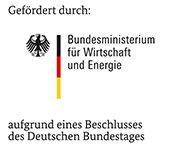17205 N

Chromium diffusion coating on ferritic-martensitic steel
| Laufzeit: | 01.07.2011 - 30.06.2013 |
|---|---|
| Geldgeber: | Bundesministerium für Wirtschaft und Technologie über AiF |
| Bearbeiter: | Diana Fähsing |
| Arbeitsgruppe: | Hochtemperaturwerkstoffe |
The main aim of modern power plant technology is an increase in efficiency. The best means to raise efficiency are steam parameters such as pressure (around 300 bar) and temperature (650°C or higher). This leads to extreme demands on the superheater components.
Suitable materials are austenitic steels and nickel base alloys. Ferritic-martensitic steels are becoming more interesting because of their much better heat transfer behavior and a lower coefficient of thermal expansion, as well as lower costs. Under these conditions the 9% Cr steels have sufficient creep strength, however their corrosion behavior needs to be improved. The oxidation resistance in water vapor containing combustion atmospheres (up to 25% in the combustion of biomass or the oxyfuel process) is not yet satisfactory.
Another field of application are interconnects of Solid Oxide Fuel Cells (SOFC). Modern SOFCs work at temperatures between 600°C and 800°C, which allows for the replacement of expensive lanthanum chromite ceramics (LaCrO3) by ferritic-martensitic steels as a material for interconnects. The metallic interconnects exhibit many advantages over ceramic materials. They have electrically conducting oxide scales, good mechanical properties, appropriate thermal expansion behavior, very low costs, excellent machinability, and they can be joined with a number of standard welding and brazing techniques.
However, there are two major issues associated with the use of stainless steels. One is the evaporation and migration of volatile chromium species from the chromia scale due to the presence of water vapor; another is the electrical resistance, which increases over time due to continuous oxidation at elevated temperatures.
This work is focused on the improvement of the oxidation behavior in water vapor environments. Due to the limited oxidation resistance in water vapor containing atmospheres, ferritic-martensitic steels (9% Cr) cannot be used at temperatures above 600°C, due to the formation of the volatile chromium oxy hydroxide species CrO2(OH)2. This species evaporates from the surface of the material and leads to accelerated breakdown of the protective chromia layer.
To improve the oxidation behavior the metal subsurface region of ferritic-martensitic steels (material: P91, P92) is enriched with manganese, chromium, and/or cobalt in the form of a diffusion coating by the pack cementation process. The influence of several coating parameters, especially a variation of the activator, selected on the basis of thermodynamic calculations, was investigated to achieve a highly enriched surface diffusion zone.
The Cr-Mn or Co-Mn spinels that form during oxidation process at high temperatures have a higher resistance against evaporation than Cr oxide in water vapor environments. The improvement of oxidation behavior was investigated with oxidation exposures at 650°C and 800°C in different water vapor containing environments.
zurück
Das IGF-Vorhaben Nr. 17205 N der Forschungsvereinigung DECHEMA e.V., Theodor-Heuss-Allee 25, 60486 Frankfurt am Main wurde über die AiF im Rahmen des Programms zur Förderung der industriellen Gemeinschaftsforschung (IGF) vom Bundesministerium für Wirtschaft und Energie aufgrund eines Beschlusses des Deutschen Bundestages gefördert.
PD Dr. Mathias Galetz
Tel.: 069 / 7564-397
E-Mail: mathias.galetz
D. Schmidt , M. Galetz, M. Schütze, Oxidation of Metals 79 (2013), 589
D. Schmidt, M.C. Galetz, M. Schütze, Surface and Coatings Technology 237 (2013), 23
D. Schmidt, M.C. Galetz, M. Schütze, Materials at High Temperatures 29 (2012), 159
Abschlussbericht (pdf, 8,4 MB)